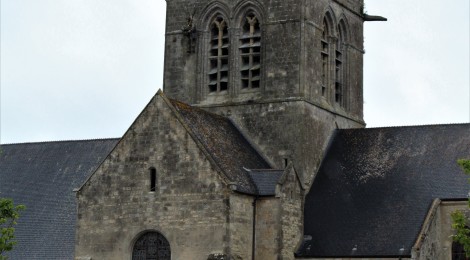
St. Mere Eglise, the Azeville Battery and Utah Beach
A little about the area:
Utah Beach was the first beach to have Allied troops land and engage the enemy. On that day, 6 June 1944, Operation Neptune, the amphibious part of Overlord, began with the landing of roughly 156,000 soldiers; ~62,000 British, ~70,000 US and ~22,000 Canadian. Paratroopers had been dropped behind enemy lines earlier in the morning to begin their assault on key targets to ensure reinforcements could not be moved forward and the Allies would have areas to advance. Side note: approximately 16,000 aircraft were used to drop ~24,000 paratroopers; ~7,000 vessels of all sizes were used to bring soldiers and supplies to the beaches.
Approximately 4,500 Allied soldiers gave their lives on D-Day.
German losses were between 4-9,000. Difficult to find an accurate number.
Within 5 days, the Allies landed ~327,000 more troops.
St. Mere Eglise is a small town that has quite a unique story. Around 1am on June 6, the 505th Parachute Infantry Regiment was dropped into this little town. Unfortunately just prior to the drop, a house had caught fire and the towns’ people were out trying to extinguish it. Along with these people was the German garrison that was stationed there, watching the folks try to put out the fire. The fire lit up the sky as bright as day! Tragically, as the paratroopers descended into the town, they were shot by the German soldiers. Some managed to survive and escape, others not so lucky. One particular paratrooper managed to survive by feigning death……..while hanging from one of the pinnacles on the church. Pvt. John Steele, 82nd Airborne, 505th PIR, hung for more than 2 hours while playing dead until the Germans retrieved him from the church and took him captive. He was later rescued by other members of the regiment. An effigy of him hanging from the pinnacle is there today.
Memorializing the events of that day, the church has two stain glass windows, one depicting the Virgin Mary with paratroopers descending on the sides and the other of St. Christopher with paratroopers on the side. Apparently St. Christopher is the patron saint of paratroopers.
On the way to Utah Beach is the Azeville Battery which was composed of 4-105mm cannons, heavy casements and tunnels. This battery is not within site of the beach so command and aiming bunkers directed fire. Approximately 250 men were stationed at Azeville. This compound has the honor of shelling one of their own positions. During D-Day, American soldiers attacked Crisbecq Battery just a few kilometers from Azeville. The commander of that site phoned Azeville and asked to be shelled to get the Americans off his bunkers before they could blast their way in. They obliged but it only delayed the inevitable. Both batteries were taken within days.



 One particular casement at Azeville was the unlucky target of the USS Nevada.
One particular casement at Azeville was the unlucky target of the USS Nevada.
The Nevada, the only warship to have the distinction of having been in both D-Day and Pearl Harbor, fired a shell that went straight through the cannon opening of this German bunker. The shell didn’t explode as it went through an internal wall, bounced off the side wall and exited through the back wall of the bunker. Although the shell didn’t explode, the massive change in air pressure caused by the shell moving through the bunker killed all 15 men inside. The shell was found in 1994 buried in a farmers field behind the bunker.
Utah Beach,
Utah Beach was fairly well fortified as part of the Atlantic Wall. Located on the Cotenin Peninsula, it was the target of the US 4th Infantry Division and 70th Tank Battalion. It was protected by 2 German battalions of the 919th Grenadier Regiment, part of the 709th Static Infantry Division. At 6:30am, 21,000 troops were landed to take Utah Beach with support from an additional 14,000 paratroopers. Casualties were lighter than expected, roughly 2,700 personnel in all including paratrooper casualties.
Prior to the landing, around 5:45am, battleships began a naval bombardment of the area. Air bombardment of the area began immediately when the naval action ceased. 300 Martin B-26 bombers attacked the area until 3 minutes before the beach landing. The results were as one would expect, very effective.
Today there are remains of casements, bunkers, command posts and housing with a labyrinth of tunnels and trenches connecting these defensive positions. Many show signs of artillery impacts.
Although Utah Beach was not the scene of the heaviest fighting, it is still a somber place that makes anyone visiting stop to imagine what it must have been like to have been there on June 6, 1944. Where do average human beings find the courage, strength and motivation to keep driving forward, even in times of certain death.























